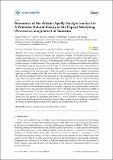| dc.description.abstract | The African apefly (Spalgis lemolea Druce) is a potential natural enemy of the papaya mealybug (Paracoccus marginatus Williams and Granara de Willink). We studied the life history of apeflies in the laboratory at a temperature of 25–27 °C and a relative humidity of 55%–65% under a 12 h photoperiod condition. The papaya mealybugs and apefly larvae were collected from papaya plants in Tengeru, Arusha, Tanzania. The papaya mealybugs were introduced and allowed to multiply on potted sprouting potato plants in screened cages. In order to study the life cycle and predation of apeflies, an apefly egg was placed on an open screen-covered petri dish containing a moist blotter paper and observed for larva emergence. After the apefly larva emergence, a mixture of mealybug eggs (up to 1500), nymphs (200–250) and adults (100–150) was introduced in the petri dish each day and the consumption rate by the apefly larvae was quantified until the larvae reached pupal stage. Then, the apefly adults were collected and put into cages 30 cm × 30 cm × 30 cm containing cotton wool soaked in water, for observation of pre-mating, mating, egg-laying and life span. Results indicate that the apefly completed its life cycle in 23 days. The mean development period of the eggs was four days and the development period for the larva, pre-pupa, and pupa was nine, one and ten days respectively. The adult apefly emerged after 9 days of the pupa stage with mean body lengths of 10.1 ± 0.4 mm and 11.0 ± 0.8 mm for the males and females, respectively. The female laid an average of 68 eggs in groups of two to seven at different sites after 4–5 days of emergence. In this study one apefly larva was capable of consuming about 1983 ± 117, 123 ± 6 and 80 ± 9 papaya mealybug eggs, nymphs and adults respectively during larval stage. These results reveal the predatory potential of the apefly in suppressing the population of papaya mealybugs under field conditions. | en_US |

